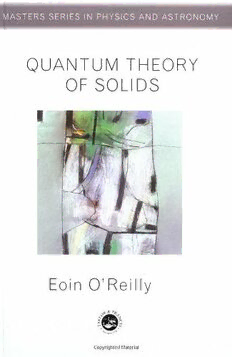Table Of ContentQuantum Theory of Solids
The Taylor & Francis Masters Series in Physics and Astronomy
EditedbyDavidS.Betts
DepartmentofPhysicsandAstronomy,UniversityofSussex,Brighton,UK
CoreElectrodynamics
SandraC.Chapman
0-7484-0622-0(PB)
0-7484-0623-9(HB)
AtomicandMolecularClusters
RoyL.Johnston
0-7484-0931-9(PB)
0-7484-0930-0(HB)
QuantumTheoryofSolids
EoinP.O’Reilly
0-7484-06271-1(PB)
0-7484-0628-X(HB)
Forthcomingtitlesintheseries:
BasicSuperfluids
AnthonyM.Guénault
0-7484-0892-4(PB)
0-7484-0891-6(HB)
Quantum Theory of Solids
Eoin P. O’Reilly
London and New York
First published 2003
by RoutledgeCurzon
11 New Fetter Lane,London EC4P 4EE
Simultaneously published in the USA and Canada
by RoutledgeCurzon
29 West 35th Street,New York,NY 10001
RoutledgeCurzon is an imprint ofthe Taylor & Francis Group
This edition published in the Taylor & Francis e-Library, 2005.
“To purchase your own copy of this or any of Taylor & Francis or Routledge’s
collection of thousands of eBooks please go to www.eBookstore.tandf.co.uk.”
© 2003 Meredith L.Weiss and Saliha Hassan;individual
chapters © the individual contributors
All rights reserved.No part ofthis book may be reprinted or
reproduced or utilised in any form or by any electronic,
mechanical,or other means,now known or hereafter
invented,including photocopying and recording,or in any
information storage or retrieval system,without permission in
writing from the publishers.
British Library Cataloguing in Publication Data
A catalogue record for this book is available from the British
Library
Library ofCongress Cataloging in Publication Data
A catalog record for this book has been requested
ISBN 0-203-21215-0 Master e-book ISBN
ISBN 0-203-26954-3 (Adobe eReader Format)
ISBN 0–7007–1646–7
Contents
SeriesPreface ix
Preface xi
1 Introductionandreviewofquantummechanics 1
1.1 Introduction 1
1.2 Wave–particleduality 2
1.3 Wavequantisation 4
1.4 Heisenberguncertaintyprinciple 5
1.5 Schrödinger’sequation 6
1.6 Expectationvaluesandthemomentumoperator 9
1.7 Somepropertiesofwavefunctions 10
1.8 Thevariationalprinciple 12
1.9 Thevariationalmethodinaninfinitesquarewell 13
1.10 Thefinitesquarewell 14
2 Bondinginmoleculesandsolids 19
2.1 Introduction 19
2.2 Doublesquarewellpotential 20
2.3 Thehydrogenmolecule,H 26
2
2.4 ThediatomicLiHmolecule 30
2.5 TetrahedralbondinginSicrystals 33
2.6 Bondingingalliumarsenide 36
2.7 Trendsinsemiconductors 36
3 Bandstructureofsolids 41
3.1 Introduction 41
3.2 Bloch’stheoremandbandstructureforaperiodicsolid 43
3.3 TheKronig–Penneymodel 46
3.4 Thetight-bindingmethod 51
3.5 Thenearlyfreeelectronmethod 55
vi Contents
3.6 Bandstructureoftetrahedralsemiconductors 61
3.7 Theuseof‘pseudo’potentials 63
4 Bandstructureanddefectsinbulksemiconductors 72
4.1 Introduction 72
4.2 k·ptheoryforsemiconductors 76
4.3 Electronandholeeffectivemasses 79
4.4 Trendsinsemiconductors 83
4.5 Impuritiesinsemiconductors 84
4.6 Amorphoussemiconductors 90
5 Physicsandapplicationsoflow-dimensional
semiconductorstructures 95
5.1 Introduction 95
5.2 Confinedstatesinquantumwells,wires,anddots 97
5.3 Densityofstatesinquantumwells,wires,anddots 99
5.4 Modulationdopingandheterojunctions 103
5.5 QuantumHalleffect 106
5.6 Semiconductorlaseraction 112
5.7 Strained-layerlasers 116
5.8 Tunnellingstructuresanddevices 119
6 Diamagnetismandparamagnetism 128
6.1 Introduction 128
6.2 Magnetisation 128
6.3 Magneticmomentoftheelectron 130
6.4 Diamagnetisminatomsandsolids 132
6.5 Langevin(classical)theoryofparamagnetism 133
6.6 Magneticmomentsinisolatedatomsandions:Hund’srules 136
6.7 Brillouin(quantummechanical)theoryofparamagnetism 139
6.8 Paramagnetisminmetals 141
6.9 Floatingfrogs 143
7 Ferromagnetismandmagneticorder 147
7.1 Introduction 147
7.2 Theexchangeinteraction 148
7.3 FerromagnetismandtheCurietemperature 151
7.4 Spontaneousmagnetisation 152
7.5 Spontaneousmagnetisationandsusceptibility
ofanantiferromagnet 153
7.6 Ferrimagnetism 157
Contents vii
7.7 Spinwaves–elementarymagneticexcitations 157
7.8 Ferromagneticdomains 160
7.9 High-performancepermanentmagnets 162
7.10 Itinerantferromagnetism 166
7.11 Giantmagnetoresistance 168
8 Superconductivity 172
8.1 Introduction 172
8.2 Occurenceofsuperconductivity 173
8.3 MagneticbehaviourandMeissnereffect 175
8.4 TypeIandTypeIIsuperconductors 176
8.5 ElectromagneticmomentumandtheLondonequation 178
8.6 TheMeissnereffect 181
8.7 Applicationofthermodynamics 183
8.8 CooperpairsandBCStheory 187
8.9 BCScoherencelength 192
8.10 Persistentcurrentandthesuperconductingwavefunction 193
8.11 Fluxquantisation 193
8.12 Josephsontunnelling 196
8.13 ACJosephsoneffect 198
8.14 High-temperaturesuperconductivity 199
Appendices
A Thevariationalmethodwithanarbitrary
parameter:theHatom 208
B ThehydrogenatomandthePeriodicTable 211
C Firstandsecondorderperturbationtheory 218
C.1 Introductiontoperturbationtheory 218
C.2 Firstorderperturbationtheory 219
C.3 Secondorderperturbationtheory 222
D Diracnotation 227
E Bloch’stheoremandk·ptheory 229
Outlinesolutionstoproblems 232
Index 243
Series preface
The Masters series of textbooks is aimed squarely at students taking
specialised options in topics within the primary areas of physics and
astronomy, or closely related areas such as physical chemistry and envi-
ronmental science. Appropriate applied subjects are also included. The
studentinterestgroupwilltypicallybestudyinginthefinalyearoftheir
first degree or in the first year of postgraduate work. Some of the books
mayalsobeusefultoprofessionalresearchersfindingtheirwayintonew
research areas, and all are written with a clear brief to assume that the
readerhasalreadyacquiredaworkingknowledgeofbasiccorephysics.
Theseriesisdesignedforuseworldwideintheknowledgethatwher-
everphysicsistaughtatdegreelevel,therearecorecoursesdesignedfor
all students in the early years followed by specialised options for those
consciouslyaimingatamoreadvancedunderstandingofsometopicsin
preparationforascientificcareer.IntheUKthereisanextrayearforthe
lattercategory, leadingtoanMPhysorMScdegreebeforeentrytopost-
graduateMScorPhDdegrees,whereasintheUSAspecialisationisoften
found mainly in masters or doctorate programmes. Elsewhere the pre-
cisemodulationsvarybutthedevelopmentfromcoretospecialisationis
normallypartoftheoveralldesign.
Authors for the series have usually been able to draw on their own
lecturematerialsandexperienceofteachinginpreparingdraftchapters.It
isnaturallyafeatureofspecialistcoursesthattheyarelikelytobegivenby
lecturers whose research interests relate to them, so readers can feel that
theyaregainingfrombothteachingandresearchexperience.
Eachbookisself-containedbeyondanassumedbackgroundtobefound
in appropriate sections of available core textbooks on physics and use-
ful mathematics. There are of course many possibilities, but examples
mightwellincludeRichardP.Feynman’sthree-volumeclassicLectureson
Physics(firstpublishedbyAddison-Wesleyinthe1960s)andMaryL.Boas’
Mathematical Methods in the Physical Sciences (Wiley, 1983). The primary
aim of books in this series will be to enhance the student’s knowledge
basesothattheycanapproachtheresearchliteratureintheirchosenfield

